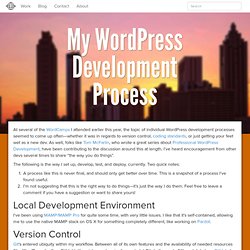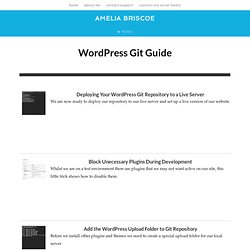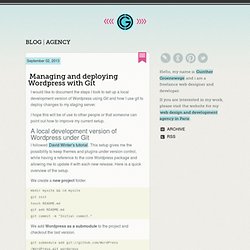

JC Deploy - Bitbucket GIT Deployment Wordpress Plugin. Introduction JC Deploy is a wordpress plugin which allows you to automatically update your development themes and plugins via remote git repositories.

Currently JC Deploy has only been developed to automatically fetch private repositories from bitbucket once a push request has been sent to your remote repository. Installation Download the plugin from its github repository here.Extract it in your WordPress plugins folder.Activate the plugin from within WordPress.Goto Tools -> Repo Deployment.Enter your Bitbucket account and repository details.Login to your bitbucket account on bitbucket.org and click on the admin section for the repository you wish to link to your wordpress account. Click on the Hooks tab and select POST from the hooks dropdown then select the Add New button.A modal window will appear prompting you to enter a url, go back to your wordpress website, goto Tools -> Repo Deployment and copy the url displayed at the top of the page e.g.
View plugin on github.com. My WordPress Development Process - Logos Creative. At several of the WordCamps I attended earlier this year, the topic of individual WordPress development processes seemed to come up often—whether it was in regards to version control, coding standards, or just getting your feet wet as a new dev.

As well, folks like Tom McFarlin, who wrote a great series about Professional WordPress Development, have been contributing to the discussion around this at length. I’ve heard encouragement from other devs several times to share “the way you do things”. The following is the way I set up, develop, test, and deploy, currently. Two quick notes: A process like this is never final, and should only get better over time. Local Development Environment I’ve been using MAMP/MAMP Pro for quite some time, with very little issues. Version Control Git‘s entered ubiquity within my workflow.
Put on some Led Zeppelin and let’s dig in by creating a new WordPress site from scratch, using the command line (which is your friend). Installing WordPress ../.. Minimalism. WordPress Git Tutorials. We are now ready to deploy our repository to our live server and set up a live version of our website.

Whilst we are on a test environment there are plugins that we may not want active on our site, this little trick shows how to disable them. Before we install other plugins and themes we need to create a special upload folder for our local server Let's continue our development workflow and use a branch to develop a WordPress plugin for our site. Let's go through a development workflow and use a branch to develop a WordPress theme for our site. We are now ready to install our WordPress website, but there is a small trick that I'll take you through below Take a walk through how to configure your WordPress Git repository on your local server before you install WordPress Clone your new WordPress Git repository onto your local desktop/laptop to start developing your website.
Start using Git and WordPress by setting up an online repository and import the WordPress start up repo. Wordpress git. Managing and deploying Wordpress with Git. I would like to document the steps I took to set up a local development version of Wordpress using Git and how I use git to deploy changes to my staging server.

I hope this will be of use to other people or that someone can point out how to improve my current setup. A local development version of Wordpress under Git I followed David Winter’s tutorial. This setup gives me the possibility to keep themes and plugins under version control, while having a reference to the core Wordpress package and allowing me to update it with each new release.
Here is a quick overview of the setup. We create a new project folder. mkdir mysite && cd mysite git init touch README.md git add README.md git commit -m "Initial commit. " We add Wordpress as a submodule to the project and checkout the last version. git submodule add wordpress git commit -m "Add Wordpress submodule.
" cd wordpress git checkout 3.6 cd .. git commit -am "Checkout latest Wordpress version" In index.php change require('. to require('. References.